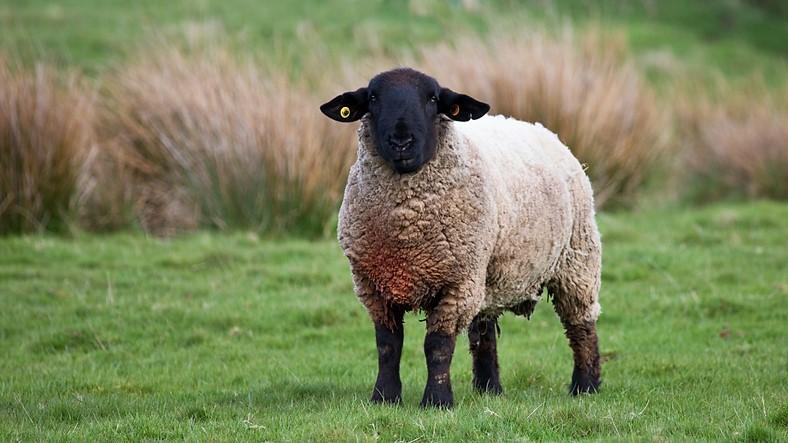
Maximising lamb output with the sale of strong and healthy lambs at a good price is the ultimate goal for every sheep producer. Yet, with an average scanning percentage of just 170% in the UK flock, this indicates that opportunities could be being missed during the very early stages of pregnancy leading to significant financial losses later down the line.
Given the significant influence of nutrition at tupping time should we then question whether grazing alone is enough, particularly as its quality takes a natural seasonal decline around the time rams are removed? And should we start to pay more attention towards supplementation at a time when the foundations for profitability are being laid?
 Net-tex Ram harness designed to accommodate Net-tex wax marker crayons:[/caption]
[caption id="" align="alignleft" width="225"]
Net-tex Ram harness designed to accommodate Net-tex wax marker crayons:[/caption]
[caption id="" align="alignleft" width="225"] Raddle crayons, available in a variety of colours[/caption]
[caption id="" align="alignleft" width="242"]
Raddle crayons, available in a variety of colours[/caption]
[caption id="" align="alignleft" width="242"] Foot Shears[/caption]
Foot Shears[/caption]
What are the key objectives at tupping?
- Achieve target ewe body condition scores
- Lowland ewe 3.5
- Hill ewe 2.5
- Optimise overall conception rates
- More than 75% of ewes hold to first cycle
- Less than 2% empty rate
Why should I supplement my ewes during this period?
- To achieve target ewe body condition to support ovulation rates and successful conception
- To optimise the number of ewes holding to first service to aid a tighter lambing period and ease of management.
- To help maintain nutrition levels after mating as grazing quality declines to support successful embryo implantation.
- To provide additional minerals and vitamins, especially cobalt and selenium which support successful embryo implantation.
Does my flock have any specific nutritional requirements around tupping time?
- Ensure adequate grass dry matter (1kg) is available to allow a response to flushing, especially for thinner ewes who will consume up to 30% more than those in optimal body condition.
- In case of restricted grazing in summer or wet grazing later in season, supplementation is recommended to help counter low dry matter intakes.
- Avoid feeding high levels of concentrates after tupping which can cause low blood progesterone levels; a hormone required for pregnancy recognition and subsequent establishment.
- Keep stress levels to a minimum by avoiding excessive handling and providing shelter in adverse weather conditions
- Do not allow access to red clover-based pastures, legumes or silage based forages 45 days before or after tupping due to their association with fertility issues
When should I offer supplements?
From 2 weeks prior to tup introduction for a total of 8 weeks supporting the ewe at tupping and during early pregnancy when embryo implantation occurs. For more information please contact one of StowAg's SQP's on 01451 830 400.Which Rumenco extra high energy and mineral lick should I choose?
Option 1: Feed Block, Rumevite Sheep Super Energy Plus Fish Oil
- Proven to increase lambing percentage by up to 22% when compared to no supplementation
- Cheaper per tonne compared to buckets
- Contains fish oil as source of omega-3 fatty acids to support pregnancy rates
- Includes selenium, cobalt and zinc to support fertility
- Expected intakes of up to 300g per ewe per day
- We recommend Rumevite blocks are offered in feeders at a ratio of one per 35 ewes
- 100 ewes will require approximately 1 tonne of Rumevite for an 8-week feeding period
Option 2: Low Moisture Bucket, MAXX Energy
- Highly controlled intake and long-lasting
- Concentrated sugar energy to optimise grass and forage utilisation
- Includes selenium, cobalt and zinc to support fertility
- Available as 22.5kg and 80kg pack weights
- We recommend offering one 22.5kg bucket per 35 ewes or one 80kg tub per 90 ewes
- Expected intakes of up to 80g per ewe per day
- 100 ewes will require approximately 0.5 tonne of MAXX for an 8-week feeding period
LIFELINE Ram Care Molassed Bucket
- Specifically formulated to support the production of hard-working males with a long productive lifetime without relying on large amounts of concentrates
- Part of the Easicare™ system developed by the SAC
- Contains selenised yeast, vitamin B12, biotin, fish oil and Diamond V XPLS to support fertility and high-performance potential
- Offer from 8 weeks pre-tupping
 Net-tex Ram harness designed to accommodate Net-tex wax marker crayons:[/caption]
[caption id="" align="alignleft" width="225"]
Net-tex Ram harness designed to accommodate Net-tex wax marker crayons:[/caption]
[caption id="" align="alignleft" width="225"] Raddle crayons, available in a variety of colours[/caption]
[caption id="" align="alignleft" width="242"]
Raddle crayons, available in a variety of colours[/caption]
[caption id="" align="alignleft" width="242"] Foot Shears[/caption]
Foot Shears[/caption]
